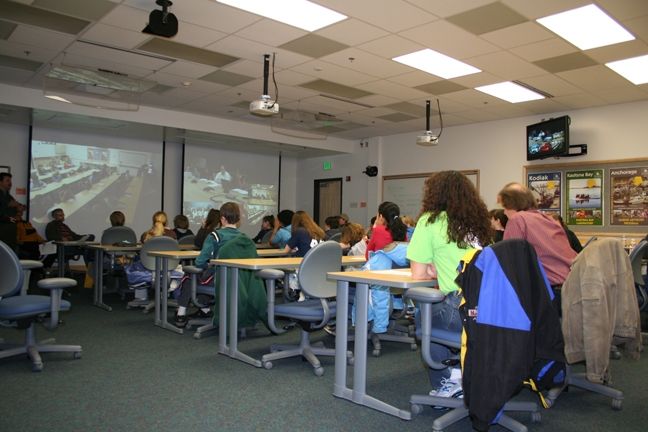 The event was based at the University of Alaska Fairbanks (UAF) and linked students from several locations around Alaska (Fairbanks, Shageluk, Wasilla) with students from Ushuaia, Argentina, at the southern tip of South America. A number of Arctic and Antarctic scientists were also on hand to answer students’ questions and to help lead the discussion.
The event was based at the University of Alaska Fairbanks (UAF) and linked students from several locations around Alaska (Fairbanks, Shageluk, Wasilla) with students from Ushuaia, Argentina, at the southern tip of South America. A number of Arctic and Antarctic scientists were also on hand to answer students’ questions and to help lead the discussion.Conversation during the two-hour videoconference progressed through three rounds. In the first round, the Alaska and Argentine students asked each other questions and exchanged observations about signs of seasonal change. In the second round, the focus shifted to how to narrow questions down so that students could investigate them, while the third round centered on discussing ways the investigations could be undertaken.
The students discovered they had many observations and concerns in common. One topic that generated a lot of interest from both hemispheres was the impact of seasonal change on snowboarding, and what kinds of investigations could be developed to explore the changes. It was noted that one low-lying ski area near Ushuaia has already been closed permanently due to lack of snow.
Besides the snowboarding idea, many other possible research topics emerged such as temperature and precipitation changes, and species succession after wildland fires. Specific ideas for climate investigations included looking at the timing of when people put on or take off their snow tires, and using frost tubes to monitor freezing and thawing in the soil in both Ushuaia and Alaska.
Students from both regions also reported on changes they had observed in their local environments that might be a result of seasonal changes, such as certain species of birds now being seen farther north than they used to be, and the movement of treeline in the mountains near Ushuaia. An Argentine student observed that a glacier that currently supplies water to Ushuaia is melting and is expected to be gone within a few decades, potentially leading to a shortage of drinking water. And at the conclusion of the videoconference, a student from the Alaskan village of Shageluk pointed out that seasonal changes are already threatening the way of life of many northern Native peoples.
Later in the week, a follow-up live web chat and web forum took place to allow further discussion of the topics and questions that were brought up at the videoconference, as well as new questions from additional students around the world. Scientists from the University of Alaska Fairbanks, the GLOBE (Global Learning and Observations to Benefit the Environment) program, and the NASA Goddard Space Flight Center responded to the questions.
These activities are part of Seasons and Biomes, an International Polar Year (IPY) project funded by the U.S. National Science Foundation and headed by Dr. Elena Sparrow of the International Arctic Research Center at UAF. This project, which is included in the UArctic IPY Higher Education and Outreach Cluster, trains K-12 teachers and students from around the world to investigate seasonal and environmental changes in their own biomes. It is part of the GLOBE program, which is funded through a cooperative agreement with NASA, the University Corporation for Atmospheric Research and Colorado State University. GLOBE engages students from 110 countries in environmental science investigations.
Read more about the Seasons and Biomes pole-to-pole videoconference in the blog of GLOBE Chief Scientist Dr. Peggy Lemone at http://www.globe.gov/fsl/scientistsblog/?p=114.
